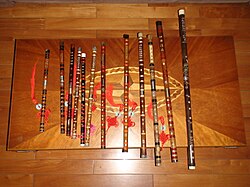 | |
| Woodwind instrument | |
|---|---|
| Hornbostel–Sachs classification | 421.121.12 (Open side-blown flutes with fingerholes) |
| Related instruments | |
| |
| Sound sample | |
The dizi (Chinese: 笛子; pinyin: dízi, pronounced [tǐt͡sɨ]), is a Chinese transverse flute. It is also sometimes known as the di (笛) or héngdi (橫笛), and has varieties including Qudi (曲笛), Bangdi (梆笛), and Xindi (新笛). It is a major Chinese musical instrument that is widely used in many genres of Chinese folk music, Chinese opera, as well as the modern Chinese orchestra. The dizi is also a popular instrument among the Chinese people as it is simple to make and easy to carry.[a]
Most dizi are made of bamboo, which explains why dizi are sometimes known by simple names such as Chinese bamboo flute. However, "bamboo" is perhaps more of a Chinese instrument classification like "woodwind" in the West. Northern Chinese dizi are made from purple or violet bamboo, while dizi made in Suzhou and Hangzhou are made from white bamboo. Dizi produced in southern Chinese regions such as Chaozhou are often made of very slender, lightweight, light-colored bamboo and are much quieter in tone.
Although bamboo is the common material for the dizi, it is also possible to find dizi made from other kinds of wood, or even from stone. Jade dizi (or 玉笛; yùdi) are popular among both collectors interested in their beauty, and among professional players who seek an instrument with looks to match the quality of their renditions; however, jade may not be the best material for dizi since, as with metal, jade may not be as tonally responsive as bamboo, which is more resonant.[dubious – discuss][1]
The dizi is not the only bamboo flute of China. Other Chinese bamboo wind instruments include the vertical end-blown xiao and the koudi.
Cite error: There are <ref group=lower-alpha> tags or {{efn}} templates on this page, but the references will not show without a {{reflist|group=lower-alpha}} template or {{notelist}} template (see the help page).
- ^ Malcolm Tattersall (Feb 2007). "Does It Matter What It's Made Of?". Retrieved September 7, 2018.